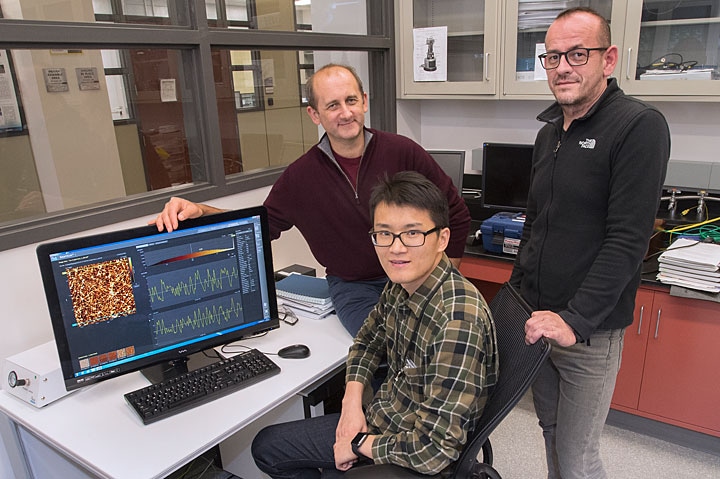Nov 14 2018
Using self-assembling wire-like nanostructures that conduct electricity, researchers from the Center for Functional Nanomaterials (CFN)—a U.S. Department of Energy (DOE) Office of Science User Facility at Brookhaven National Laboratory—have considerably enhanced graphene’s response to light.
 (Image credit: Brookhaven National Laboratory)
(Image credit: Brookhaven National Laboratory)
This dramatic improvement could lead to the development of sophisticated graphene-based detectors that can rapidly sense light at extremely low levels, like those found in surveillance, radiation detection, and medical imaging applications.
The two-dimensional (2D) nanomaterial, graphene, has unique and useful electronic, optical, and mechanical properties. The material is very thin, remarkably strong, detects light of virtually any color, and conducts electricity and heat relatively well. Conversely, since graphene is made of carbon sheets that have just one-atom thickness, it can absorb only an extremely small amount of incoming light (approximately 2%).
One way to resolve this issue is to integrate graphene with powerful light-absorbing materials, for example, organic compounds that are capable of conducting electricity. Recently, researchers placed thin films (measuring a few tens of nanometers) of one such conductive polymer called poly(3-hexylthiophene), or P3HT, on top of a single graphene layer to demonstrate a better photoresponse.
Now, by altering the polymer’s morphology or structure, the CFN researchers have enhanced the photoresponse by an extra 600%. Rather than using thin films, the team utilized a mesh of nanowires made of the same polymer and analogous thickness. The length of these nanostructures was many times greater than their width. The study has been described in an article published online on October 12th, 2018 in ACS Photonics, a journal of the American Chemical Society (ACS).
We used self-assembly, a very simple and reproducible method, to create the nanowire mesh. Placed in an appropriate solution and stirred overnight, the polymer will form into wire-like nanostructures on its own. We then spin-casted the resulting nanowires onto electrical devices called graphene field-effect transistors (FETs).
Mingxing Li, Research Associate and Study First Author, Soft and Bio Nanomaterials Group, Center for Functional Nanomaterials.
The researchers developed FETs made of graphene and P3HT nanowires, graphene and P3HT thin films, and graphene only. Then, they examined the crystal structure and thickness of the FET devices using Raman spectroscopy, atomic force microscopy, and X-ray scattering methods, and finally determined their light-induced electrical properties or photoresponsivity. The researchers’ measurements of electricity flowing through the FETs under different light illumination powers showed that the nanowire FETs enhance photoresponse by as much as 600% when compared to the thin-film FETs, and as much as 3000% when compared to graphene-only FETs.
We did not expect to see such a dramatic improvement just by changing the morphology of the polymer.
Mircea Cotlet, Materials Scientist and Study Co-Corresponding Author, Soft and Bio Nanomaterials Group, Center for Functional Nanomaterials.
According to the team, two explanations are there behind their observations.
“At a certain polymer concentration, the nanowires have dimensions comparable to the wavelength of light,” stated Li. “This size similarity has the effect of increasing light scattering and absorption. In addition, crystallization of P3HT molecules within the nanowires provides more charge carriers to transfer electricity to the graphene layer.”
In contrast to conventional thin films where polymer chains and crystals are mostly randomly oriented, the nanoscale dimension of the wires forces the polymer chains and crystals into a specific orientation, enhancing both light absorption and charge transfer.
Dmytro Nykyphanchuck, Materials Scientist and Study Co-Author, Soft and Bio Nanomaterials Group, Center for Functional Nanomaterials.
A U.S. patent for their fabrication process has been filed by the researchers, who are looking forward to study light-matter interactions in other 0D, 1D, and 2D materials as well.
“Plasmonics and nanophotonics—the study of light at the nanometer scale—are emerging research areas,” stated Cotlet, who earlier this year co-organized a workshop for user communities of the CFN and the National Synchrotron Light Source II (NSLS-II)—another DOE Office of Science User Facility at Brookhaven—to investigate frontiers in these fields. “Nanostructures can manipulate and control light at the nanoscale in very interesting ways. The advanced nanofabrication and nanocharacterization tools at the CFN and NSLS-II are perfectly suited for creating and studying materials with enhanced optoeletronic properties.”